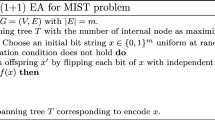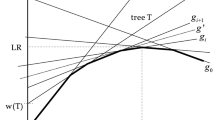Abstract
The search behavior of an evolutionary algorithm depends on the interactions between the encoding that represents candidate solutions to the target problem and the operators that act on that encoding. In this paper, we focus on analyzing some properties such as locality, heritability, population diversity and searching behavior of various decoder-based evolutionary algorithm (EA) frameworks using different encodings, decoders and genetic operators for spanning tree based optimization problems. Although debate still continues on how and why EAs work well, many researchers have observed that EAs perform well when its encoding and operators exhibit good locality, heritability and diversity properties.
We analyze these properties of various EA frameworks with two types of analytical ways on different spanning tree problems; static analysis and dynamic analysis, and then visualize them. We also show through this analysis that EA using the Edge Set encoding (ES) and the Edge Window Decoder encoding (EWD) indicate very good locality and heritability as well as very good diversity property. These are put forward as a potential explanation for the recent finding that they can outperform other recent high-performance encodings on the constrained spanning tree problems.
Similar content being viewed by others
Explore related subjects
Discover the latest articles, news and stories from top researchers in related subjects.References
Alternberg L (1997) Fitness distance correlation analysis: an instructive counterexample. In: Proceeding of the seventh international conference on genetic algorithms. Morgan Kaufmann, San Mateo, pp 57–64
Bean JC (1994) Genetic algorithms and random keys for sequencing and optimization. ORSA J Comput 6(2):154–160
Chou H, Premkumar G, Chu CH (2001) Genetic algorithms for communications network design-an empirical study of the factors that influence performance. IEEE Trans Evol Comput 5(3):236–249
Chu PC, Beasley JE (1998) A genetic algorithm for the multidimensional knapsack problem. J Heuristics 4:63–86
Deo N, Kumar N (1996) Computation of constrained spanning trees: a unified approach. In: Lecture notes in economics and mathematical systems, vol 450. Springer, Berlin, pp 194–220
Eckert C, Gottlieb J (2002) Direct representation and variation operators for the fixed charge transportation problem. In: Parallel problem solving in nature VII. Lecture notes in computer science, vol 2439. Springer, Berlin, pp 77–87
Gaube T, Rothlauf F (2001) The link and node biased encoding revisited: bias and adjustment of parameters. In: Evo worshop 2001. Lecture notes in computer science, vol 2037. Springer, Berlin, pp 1–10
Gen M, Chen R (1997) Genetic algorithms and engineering design. Wiley, New York. Also see (for Prüfer encoding): http://www.ads.tuwien.ac.at/publications/bib/pdf/gottlieb-01.pdf
Gottlieb J, Eckert C (2000) A comparison of two representations for the fixed charge transportation problem. In: Parallel problem solving in nature VI. Lecture notes in computer science, vol 1917. Springer, Berlin, pp 345–354
Gottlieb J, Julstrom BA, Raidl GR, Rothlauf F (2000) Prüfer numbers: a poor representation of spanning trees of evolutionary search. Working papers in information systems. University of Bayreuth
Gottlieb J, Raidl GR (2000) The effects of locality on the dynamics of decoder-based evolutionary search. In: Proceedings of the 2000 genetic and evolutionary computation conference. Morgan Kaufmann, San Francisco, pp 283–290
Jones T, Forrest S (1995) Fitness distance correlation as a measure of problem difficulty for genetic algorithms. In: Proceedings the sixth international conference on genetic algorithm. Morgan Kaufmann, San Francisco, pp 184–192
Julstrom BA (2001) The Bolb code: a better string coding of spanning trees for evolutionary search. In: Genetic and evolutionary computation conference. Morgan Kaufmann, San Francisco, pp 256–261
Krishnamoorthy M, Ernst A, Sharaiha Y (2001) Comparison of algorithms for the DC-MST. J Heuristics 7:587–611
Kruskal JB (1956) On the shortest spanning tree of a graph and the travelling salesman problem. In: Proceedings of the American mathematical society, vol 7, no 1, pp 48–50
Manderick B, de Weger M, Spiessens P (1991) The genetic algorithm and the structure of the fitness landscape. In: The 4th international conference on genetic algorithms, pp 143–150
Merz P, Freisleben B (2000) Fitness landscapes, memetic algorithms, and greedy operators for graph bipartitioning. Evol Comput 8(1):61–91
Palmer CC, Kershenbaum A (1995) An approach to a problem in network design using genetic algorithms. Networks 26:151–163
Palmer CC, Kershenbaum A (1994) Representating trees in genetic algorithms. In: Proceedings of the IEEE conference on evolutionary computation, pp 379–384
Paulden T, Smith DK (2006) From the dandelion code to the rainbow code: a class of bijective spanning tree representations with linear complexity and bounded locality. IEEE Trans Evol Comput 10(2):108–123
Picciotto S (1999) How to encode a tree. PhD dissertation, University of California, San Diego
Prim R (1957) Shortest connection networks and some generalisations. Bell Syst Tech J 36:1389–1401
Raidl GR (2000) An efficient evolutionary algorithm for the degree-constrained minimum spanning tree problem. In: Proceedings of the IEEE CEC, pp 104–111
Raidl GR, Gottlieb J (2005) Empirical analysis of locality, heritability and heuristic bias in evolutionary algorithms: a case study for the multidimensional knapsack problem. Evol Comput 13(4):441–475
Raidl GR, Julstrom B (2003) Edge-sets: an effective evolutionary coding of spanning trees. IEEE Trans Evol Comput 7(3):225–239
Reeves CR, Yamada T (1998) Genetic algorithms, path relinking, and the flowshop sequencing problem. Evol Comput 6:45–60
Rothlauf F (2003) Locality, distance distortion, and binary representations of integers. Working papers in information systems, University of Mannheim
Rothlauf F, Goldberg DE, Heinzl A (2002) Network random keys—a tree network representation scheme for genetic and evolutionary algorithms. Evol Comput 10(1):75–97
Rothlauf F, Goldberg DE (2003) Redundant representations in evolutionary computation. Evol Comput 11(4):381–415
Schuter P (1995) Artificial life and molecular evolutionary biology. In: Moran F et al. (eds) Advances in artificial life. Springer, Berlin, pp 3–19
Schindler B, Rothlauf F, Pesch H (2002) Evolution strategies, network random keys, and the one-max tree problem. In: Evoworkshops. Springer, Berlin, pp 143–52
Sendhoff B, Kreutz M, Seelen WV (1997) A condition for the genotype-phenotype mapping: causality. In: Proceedings of the seventh international conference on genetic algorithms. Morgan Kauffman, San Mateo
Soak MS, Corne D, Ahn BH (2004) A powerful new encoding for tree-based combinatorial optimisation problems. In: Parallel problem solving in nature VIII. Lecture notes in computer science, vol 3242. Springer, Berlin, pp 430–439
Soak MS, Corne D, Ahn BH (2006) The edge-window-decoder representation for tree-based problems. IEEE Trans Evol Comput 10(2):124–144
Soak MS (2006) A new evolutionary approach for the optimum communication spanning tree problem. IEICE Trans Fundam Electron, Commun Comput Sci E89-A(10):2882–2893
Soak MS, Corne D, Ahn BH (2004) A new encoding for the degree constrained minimum spanning tree problem. In: KES 2004. Lecture notes in artificial intelligence, vol 3213. Springer, Berlin, pp 952–958
Stadler PF (1996) Towards a theory of landscapes. In: Complex systems and binary networks. Lecture notes in physics, vol 461. Springer, New York, pp 77–163
Thompson E, Paulden T, Smith DK (2007) The dandelion code: a new coding of spanning trees for genetic algorithms. IEEE Trans Evol Comput 11(1):91–100
Watson JP, Barbulescu L, Whitley LD, Howe AE Contrasting structured and random permutation flow-shop scheduling problems: search-space topology and algorithm performance. http://www.cs.colostate.edu/~genitor/Pubs.html
Weinberger ED (1990) Correlated and uncorrelated fitness landscapes and how to tell the difference. Biol Cybern 63:325–336
Zhou G, Gen M (1998) An effective GA approach to the quadratic minimum spanning tree problem. Comput Oper Res 25(3):229–237
Author information
Authors and Affiliations
Corresponding author
Rights and permissions
About this article
Cite this article
Soak, SM., Jeon, M. The property analysis of evolutionary algorithms applied to spanning tree problems. Appl Intell 32, 96–121 (2010). https://doi.org/10.1007/s10489-008-0137-8
Received:
Accepted:
Published:
Issue Date:
DOI: https://doi.org/10.1007/s10489-008-0137-8




